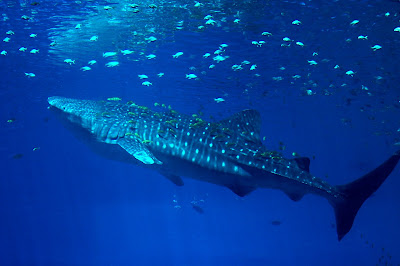Although most people do not think of sharks that way, they are actually fishes, but they are a little bit different to the ones most of you will probably have in mind. Unlike the tipical fish that we all recognise as such, which are Osteichthyes (bony fishes), sharks are Chondricthyes, which means that they are cartilaginous fishes. Their skeletons aren not made out of bone, but out of cartilage. They are related to other fishes such as rays, skates or chimaeras.
The fact that their skeleton is made out of cartilage makes them more flexible and lighter, which makes swimming less energy demanding for them. However, there are parts of the shark that, due to mechanical stress, need to be a little bit more rigid and, therefore, have evolved in such a way that they have a similar strength to bones. The jaw, for example, is covered in a layer of hexagonal plaques made of calcium salts known as tesserae. Depending on the size of the shark, there can be more than one layer of these, making the structure more resistant.
Their teeth are as amazing if not more than their skeleton. They are embedded in the shark's gums, unlike other animals, which have them fixed to their jaw. Thanks to this, they can constantly replace their teeth during their life and, in consecuence, always have a row of teeth ready to deal with the tissues of their prey.
Most bony fish have a bladder full of gas that regulates their buoyancy, but sharks don't, so they have found other ways to keep themselves at the right depth. Their livers are full of oil and, along with their cartilaginous skeleton, they are almost able to have the right buoyancy. Almost is not enough, fortunately, they fix that by swimming all the time to avoid sinking.
Senses are probably one of the most amazing characteristics of sharks. Apart from having good sight, specially when swimming in dark water, and having a great sense of smell, being able to smell one part of blood in a million of water, they have a special sense. They can detect electromagnetic fields thanks to organs called ampullae of Lorenzini. They can sense electric impulses from other animals and also the magnetic field of the Earth, which they use to orientate.
Sharks come in all shapes, sizes and shapes, everyone more fascinating than the previous one. Some are fierce predators, others calm filtering creatures, but one thing is for sure, they are all amazing. If you have any question, write it in the comments and I will happily answer it.
 |
| Photo by: Elias Levy https://flic.kr/p/oHVLa6 |
Their teeth are as amazing if not more than their skeleton. They are embedded in the shark's gums, unlike other animals, which have them fixed to their jaw. Thanks to this, they can constantly replace their teeth during their life and, in consecuence, always have a row of teeth ready to deal with the tissues of their prey.
 |
| Photo by: Mike Johnston https://flic.kr/p/6PGGq |
Senses are probably one of the most amazing characteristics of sharks. Apart from having good sight, specially when swimming in dark water, and having a great sense of smell, being able to smell one part of blood in a million of water, they have a special sense. They can detect electromagnetic fields thanks to organs called ampullae of Lorenzini. They can sense electric impulses from other animals and also the magnetic field of the Earth, which they use to orientate.
Sharks come in all shapes, sizes and shapes, everyone more fascinating than the previous one. Some are fierce predators, others calm filtering creatures, but one thing is for sure, they are all amazing. If you have any question, write it in the comments and I will happily answer it.

Comentarios
Publicar un comentario